November 18th, 2013 § § permalink
With companies realizing the importance of being on social media, comes the interesting advent of poorly managed accounts.
Every digital marketer out there has their eyes on the prize: the metaphorical “gold pot” at the end of the digital marketing rainbow: virality.
With the quest for virality comes a delicate balancing game. All too often, the best intentioned tweets or attempts at hashtag creation end disastrously.
For example, recent headlines highlighted JP Morgan’s attempt at using a Twitter hashtag #AskJPM to engage its followers in addition to its attempt at attracting student engagement.
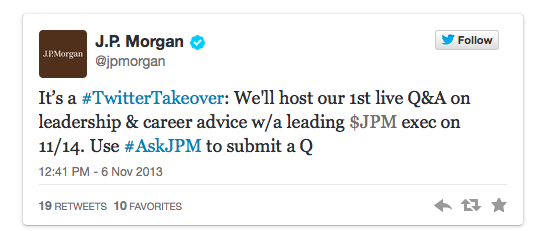
However, this hashtag severely backfired…

JP Morgan has since cancelled their Twitter chat… and has yet to post anything else.
Source: Mashable
Having effective social media crisis management strategy in place is imperative for any company on social media.
Statistics show that those in the 18-34 age category are the most annoyed at slow responses from companies on social media. On Twitter, companies such as Hootsuite have developed a separate Twitter channel just for helping its customers and Translink actively respondes to customer tweets with helpful information.
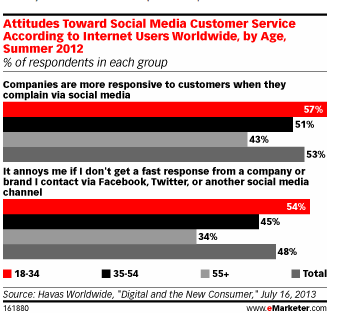
Source : eMarketer
It is important to realize that a company cannot possible please everyone on social media by responding to everything. Response in moderation and relevance is key to not getting swallowed up whole by the demands of the social public. Response however is necessary before having something spiral completely out of control. Having a social media crisis management strategy in place is extremely important for companies in the ever evolving world of social media.
Another example that gained virality for unsightly reasons is the case of Amy’s Baking Company from Spring 2013 that stemmed from an episode of Kitchen Nightmares by Gordan Ramsey.
Responding to everyone and accusing people of sabatoging their business, Amy and Samy’s Facebook page was quite an unbelievable sight. In the world of social media, it is imperative to realize that whatever content that is posted is eternal–everything is recorded somewhere by some website or search engine online.
It is better to admit faults when faults happen and move fowards; people equally share about negative and positive experiences on social media so there is definteily room for recovery ( unless you continue to exacerbate the situation a la Amy’s Baking Company ).
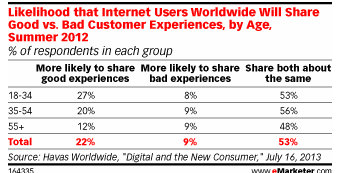
Source: eMarketer
Changing user sentiment and ultimately moving forward will help rebuild a brand’s credibility in the eyes of the public. Having appropriate measures such as teaching all employees how to act and react online and offline are also key to maintaining a strong brand image. Detracting attention from company errors such as ill informed tweets or comments and accentuating positive things that the company has done, said by users across social media is also another way to diffuse the situation. Of course, this must be done when appropriate. It is again, a delicate balancing act between corporate goals, values and customer service. Choosing to reply or engage with users who have no intention to “let go” of a problem after it has been solved is not a smart way to go about doing things. Monitoring social media and the eSphere for conversations is also a key component of a successful social media strategy that brands must implement. Monitoring using Hootsuite is a good example of a way to identify potential risks as well as opportunities.
All in all…. social media mishaps are bound to happen. If a brand survives them …that is another story.
Brands must:
1) Choose their battles –> Do not respond to everything / everyone.. not everything can be solved via social media
2) Be authentic and own up to mistakes; apologies sometimes are not a quick fix to a problem, but can be a good first step for a company to mend its reputation both on and offline.
3) Mitigate risk by constant monitoring
4) Teach all employees the importance of social media etiquette and conduct, not just the ones that run SM accounts.
5) Carefully plan social media content by identifying potential pitfalls ( eg. #AskJPM) and ensure that nothing disastrous can result
October 16th, 2013 § § permalink
While there are a variety of social media platforms widely used today, Snapchat being used for brands is relatively new. Snapchat is an app that enables users to send photos and videos that will disappear after a certain amount of time once clicked. To view a Snapchat, users must physically touch the screens of their smartphones.
Brands are always looking for ways to engage and customize the experiences of its customers and the use of Snapchat to do so is innovative. Snapchat is yet another avenue that brands can use to personalize relationships with consumers. To receive an exclusive Snapchat from the brand, users must first be friends with them. Taco Bell was one of the first to experiment with the Snapchat platform, urging its followers to friend them. An article in Techcrunch ( also ref. the Taco Bell & Snapchat), also points to the fact this could be an interesting platforms for ads. I agree with this–the extra step of having to touch the screen in order to watch and knowing that the message will disappear after 10 seconds is enough to keep most users’ curious enough to pay attention.
Recently, fashion designer Rebecca Minkoff chose to use Snapchat to give her loyal fans a preview of 5-10 pieces of her new collection :
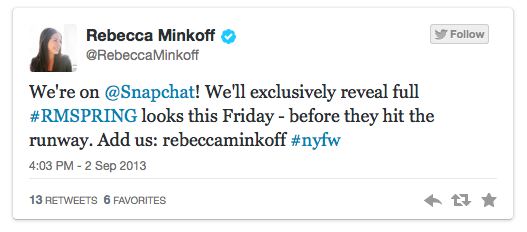
Content consumption is part of our daily routine. I am extremely curious to see if more brands will start using Snapchat to further bridge the divide between company and consumer. Snapchat’s new introduction of it’s “Stories” platform allows for longer Snaps which makes it even more attractive for companies to engage in creating platform specific content for fans.
A yogurt company in New York called 16 Handles experimented with an idea : sending its friends a mystery coupon with discount ranging from 16%-100% after users sent it a Snap of them trying a flavour a location. This has some caveats though, as the user must open the Snapchat and the cashier must scan it within 10 seconds, before the message self destructs.
I am extremely intrigued by this new platform for brand and consumer interaction –if Snapchat makes a way for brands to save these messages –perhaps they can use the UGC on other platforms such as Facebook. All in all, Snapchat is a relatively new social media platform with possibilities that have not yet fully been explored. Snapchat enables brands to become more “friend” like with consumers in a way that is not possible through other social networks. I think this has great potential for strengthening brand equity and customer relationships.
September 29th, 2013 § § permalink
With the rise of social media platforms such as Twitter, Facebook Instagram and Youtube, brands have realized that in order to survive they must literally “engage or die”. However, most users feel that an accurate measure of influence is how big of a following these brands have. With the scramble for attracting followers, comes the rise of questionable businesses that satisfy this need: sites that allow for you to buy followers at cheap costs.
“Followers”
A common conversation I’ve noticed among people is the topic of how large of a following do you have? With brands this is the same; certain accounts amass 10,000+ followers to a million+ and I cannot help but wonder how many of those users are fake as it is very strange to see large jumps in follower base ( 10,000+ ) in a short period of time ( see Mashable infographic below re: Mitt Romney)
Every now and then I have noticed fake profiles on social media such as Twitter and Instagram where the users basically are spamming other users with links that are usually linked to unauthorized downloads such as phising sites or in the case of Instagram, there are users with photos of text that say some iteration of ” follow me to get 100, 000 k followers” or go to this website to go to to buy “real” followers.
Faking influence can prove dangerous as brand can run the risk of real users discovering their fake following and developing distrust for the brand. Brands that purchase fake followers may not reap rewards such as an increase in sales of product in real life or online, or any increase in real followers. The practice of fake followers is both unethical and risky to businesses, personalities and brands.
The Business of Fake Follower Generation
The fake follower / generation of the illusion of social influence has created quite a profitable business for the social media black market.
“According to the RSA, the security division of cloud computing company EMC, 1,000 Instagram “likes” cost marketers roughly $30, while 1,000 followers cost about $15. These packages of “likes” and followers are sold on Internet hacker forums — the same forums where hackers sell credit card data. For comparison, a batch of 1,000 credit card numbers cost just $6.” –Kurt Wagner, for Mashable .
These numbers alone are quite horrifying… social media influence is indeed extremely valuable as 1,000 likes costs more than 1000 credit card numbers.
However cheap building an assumed large following is, there is no replacement for an authentic fan base.
Authetic Influence
Authentic engagement creates authentic influence. Brands need to actively engage in conversations with real followers ( their social media managers should make sure they are not talking to fake social media accounts) to create a larger fan base. Authentic engagement allows for brands to create online personalities and interact with users in a real non robot like way. Social media was invented for the purpose of two way conversations and its ability for consumer engagement should be harnessed. Brands that just tweet or advertise deals and never respond to customer complaints or comments are likely not to be as successful as those that do.
Take for example the Twitter account @dkny 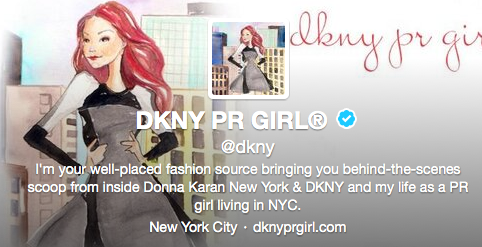
Is a brilliant take on building authentic influence. From actively engaging her followers in conversations and having quirky comebacks and engaging in moments such as being able to suggestively persuade a potential client to purchase the signature DKNY cozy ( see below screenshot), @DKNY is a brilliant example of how authentic engagement builds a unique personality that upholds both brand values and creates brand buzz to the point where her revealing her true identity was a big deal in the social media space.
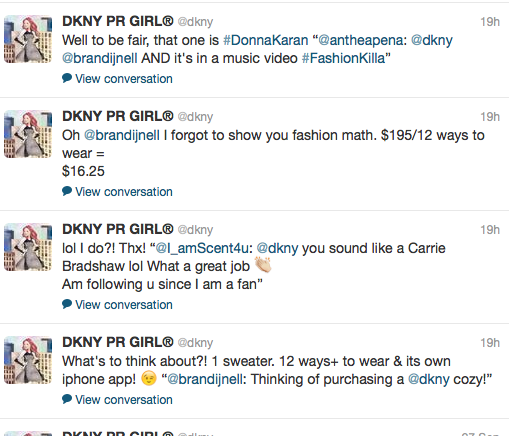
Here is a helpful infographic regarding Fake Twitter Followers from Mashable below:

What’s your take on social media authenticity? Is it worth the risk to generate a large following and hope that real users will also like and follow? Would love to hear your thoughts!







